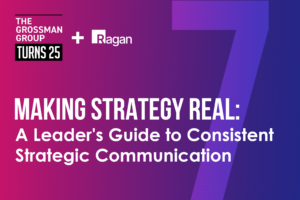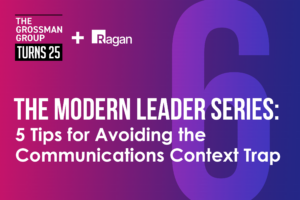Leading through change: Lessons from Boeing and Starbucks
Unpacking change at two major organizations.

Jennifer George Caligiuri is senior vice president of communications at The Aspen Group.
Two of Seattle’s most influential companies, Boeing and Starbucks, are navigating existential transformations under new leadership, setting timely examples for strategic communications leaders guiding their executive teams through similar change. In addition to urgent financial pressure, both companies face pressing workforce issues.
Last week, Boeing factory workers voted to accept a contract offer and end their strike after more than seven weeks, paving the way for the company to restart its idled Pacific Northwest assembly lines. While Boeing’s leadership works to rebuild trust and navigate post-strike operations, Starbucks remains focused on fostering dialogue around fair wages and working conditions.
At Boeing, CEO Robert Kelly Ortberg faces additional challenges. The company needs to address production issues, strengthen its supply chain, and rebuild trust all while under intense regulatory oversight. Ortberg’s response has been clear and deliberate about the four key jobs to be done: return to engineering excellence, stabilize the workforce, strengthen quality control, and rebuild customer confidence through transparency.
Similarly, Starbucks’ new chief Brian Niccol is pursuing what he calls a “Back to Starbucks” vision. With customer traffic declining and employee satisfaction at stake, he’s working to reconnect the brand with its roots as a community gathering place. His focus: streamline operations, enhance the customer experience, and revive what made people connect with Starbucks in the first place.
For comms pros, these transformations offer rich insights into how to support leaders during periods of significant change. So what can we learn from how their first few months are shaping their tenure?
Your legacy is your secret weapon
You can’t renovate a house when your foundation is cracking. This is why both leaders have started with a simple but powerful framing device: remembering what made their companies great in the first place.
At Boeing, Ortberg is restoring engineering excellence to the heart of everything they do. In a recent earnings call, he described his mission as turning “this big ship in the right direction and restoring Boeing to the leadership position that we all know and want.”
Over at Starbucks, Niccol wants to return to what made people fall in love with the brand – being that warm, welcoming neighborhood coffee shop. His philosophy centers on the idea of “getting back to our core identity and consistently delivering a great experience, our customers will come back.”
When you’re helping a CEO communicate change, tapping into the company’s DNA can be incredibly powerful. This is not some self-serving nostalgia of the past; it’s about using those strong emotional connections to build something new. Your job is to help tell that story in a way that makes both employees and customers think, “Yes, this is the company I know and love – and I’m excited about where we’re heading.”
Start by diving deep into your archives and sitting down with veteran employees – they hold the stories that shaped your company’s soul. Take these heritage moments and draw direct lines to your current initiatives, showing how today’s changes honor your founding principles. Guide your leaders in weaving their connections to company history into every communication. Most importantly, capture those powerful cross-generational stories from employees and customers that show your values aren’t just words on a wall – they’re living principles that have guided your company through decades.
Leadership in the trenches is non-negotiable
When the heat rises, the corner office isn’t where solutions live. This is why one of Ortberg’s first moves after being appointed CEO was to relocate from Florida to Seattle and physically show up on the factory floor. His candid admission during Boeing’s Q3 earnings call was that leadership had lost touch with frontline workers: “And I’ll tell you, I don’t think our people are close enough to the people in the labs, on the factory floor, identifying what’s keeping us from being successful.“
Similarly, Niccol made it a priority to hear directly from baristas and store managers around the country in his first 50 days. And that handoff between barista and customer is so important at Starbucks that Niccol even told investors that based on direct feedback from these frontline conversations, he’s already made changes to bring back the coffee condiment bar and is rolling out other pilots to help address staffing.
The mandate is clear for comms pros — Stop crafting messages in some isolated boardroom disconnected from your people. The most powerful stories come from the shop floor, the lab, and the front counter. When a CEO rolls up their sleeves and listens to the people doing the work and engaging with customers, you’ve got something no press release can deliver: authenticity in action. Share these stories. But most importantly, help make them happen.
Just tell it like it is
At Boeing, Ortberg didn’t hide behind buzzwords or vague promises. He stripped away the complexity and stated the obvious truth: Boeing is an airplane company. And they need to rebuild trust. Full stop. There are no flowery mission statements about “reimagining aerospace solutions.” Just the unvarnished reality of what needs fixing. Starbucks’ Niccol showed the same courage.
Instead of glossing over challenges with marketing speak about “enhanced customer journeys,” he admitted the hard truth: They’d made it too difficult to be a customer. They’d gotten caught up in rewards programs while forgetting what brought people through their doors in the first place. Here’s the critical lesson: Stop sanitizing your leaders’ messages until they’re meaningless. Real trust isn’t built on perfectly crafted statements, it’s built on raw truth. Get your executives comfortable with simple, direct language that calls out problems by name. Help them strip away the corporate veneer and speak like actual humans. When a CEO says “We messed up” instead of “We identified operational inefficiencies,” people don’t just listen and then roll their eyes, they believe.
What this means for you as an advisor:
When you’re supporting a CEO or leadership team through major change or turnaround:
- Push for honesty. Clear, straightforward communication about challenges builds more trust than any polished corporate message.
- Use your company’s history as a strength. People love a good comeback story – help them see how the past connects to an exciting future.
- Keep it simple. Break down complex strategies into clear steps that everyone can understand and support. Remember: the best turnaround strategy is useless if people don’t understand how they can help deliver it.
- Show, don’t just tell. Support your CEO in getting out there and connecting with employees. Suggest they move their desk to the production floor a la Kelly Ortberg. These real interactions short-circuit the game of telephone that can happen in big organizations.
- Set realistic expectations. Help everyone understand that meaningful change is a process not a single event.
People can handle bad news. What they can’t handle is feeling like they’re being fed a line. Your job isn’t to make things sound better than they are. It’s to help leaders tell the truth in a way that builds confidence in the path forward.







